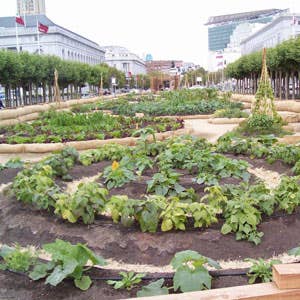
The Making of a Garden
San Francisco’s new victory garden revives a venerable tradition and helps kick off this weekend’s Slow Food Nation.
In front of San Francisco's gilded city hall, scarlet runner beans scurry up bamboo stakes and rows of heirloom lettuces create a kaleidoscope of colors. Even corn, squash, and beans—a medley traditionally planted in the Southwest—are thriving.
The Slow Food Nation Victory Garden, which was unveiled on July 1, was proposed to the city almost a year ago by a group of artists and gardeners, but the idea of a garden in the middle of a U.S. city first took root long before that.
The first community gardens in America sprouted up during the 1893 depression. Hazen Pingree, a resourceful Detroit mayor, decreed that vacant city land should be used for growing food for the hungry. Land near downtown Detroit was leased to the unemployed, who were able to raise food for their families and sell any surplus. The project took off and spread to cities like Philadelphia and New York. When the depression ended, though, so did the potato patches.
During the First World War, the idea resurfaced, and people were urged to plant war gardens; throughout World War II, such gardens became known as victory gardens. In the 1970s, a recession looming, books like The Integral Urban House encouraged city dwellers to convert their parking spaces into gardens and raise chickens in the backyard.
Over the past ten years, urban agriculture has made yet another comeback, supported by nonprofits, academics, and modern-day urban farmers like me. I live (along with several goats and a flock of chickens) near downtown Oakland, where I tend my own vegetable garden. So, in May, when I caught wind of the neo-victory garden project in San Francisco, I hustled over to a small greenhouse in a forlorn part of town to help.
Amy Franceschini, an artist and one of the garden's founders, was up to her elbows in potting soil, filling seedling trays. John Bela, one of the garden's architects, had just arrived with donated seeds from Seeds of Change, an organization focused on providing organic, heirloom seeds. Willow Rosenthal, of City Slicker Farms—the organization that supplied the horticultural know-how for the undertaking—was busy building a table for the sowing project.
Bela rolled out the design for the garden. The city planned to remove the lawn in front of city hall. Instead of double-digging and amending the soil, Bela decided to make raised, circular beds that would house roughly 4,000 plants.
We spent the afternoon tucking all manner of heirloom seeds, including Greek amaranth, Cherokee Trail of Tears beans, and Aunt Molly's tomatillos, into potting trays. Rosenthal confessed her love for amaranth and described how the striking, 12-inch red catkins would wave in San Francisco's breezes. The seeds produce a high-protein grain, and the leaves can be used as a vitamin-rich green for salads or stir-fries. More than about vegetables, though, we were thinking about the significance of the garden, which promises to change expectations about how a city should look and where urban food should be grown.
Recently, after the plants we had sown had been relocated to the garden, I went to have a look. The round beds are lush and colorful, the pathways between them well planned; and hay bales offer places to sit and anticipate the ripening of the tomatoes, the arrival of the first squash, and the wave of the amaranth. This weekend, in conjunction with the events of Slow Food Nation, the produce will be harvested and donated to people in areas with limited access to fresh, organic produce.
As I sat and mused about the Slow Food Nation Victory Garden, I could not shake the memory of all those urban gardens that had come and gone before. In fact, the very spot for this garden had been the site of a war garden planted in 1918. Then the garden was removed and a lawn laid down in its place. This time, I hope, the sight of ripened vegetables and the promise of the bellies they'll fill will not be so easy to forget. And I suspect that of the thousands of people who flock to the garden this weekend, many will leave armed with the determination to start victory gardens in their own home cities.
Keep Reading
Continue to Next Story










